The Living, the Dead, and the Endangered
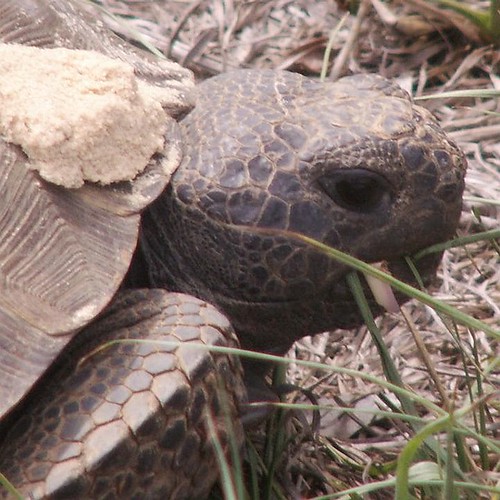
Gopher tortoise by the side of our local county road. I took this photo from a distance, with a 12x optical zoom.
Sights back at home, on "the Nature Coast"....
Near the start of what would become a 7-mile walk on the last day of May, Mary and I had crossed our recently-widened county road. We'd gone to the animal clinic to return some kibble, now that we've started Daisy on a special renal diet. The clinic, and other establishments on that side of the street, border woodlands that are home to the Chuck-Will's-Widows that I'd recorded here.
Suddenly I heard Mary gasp behind me. I turned to her. She pointed.
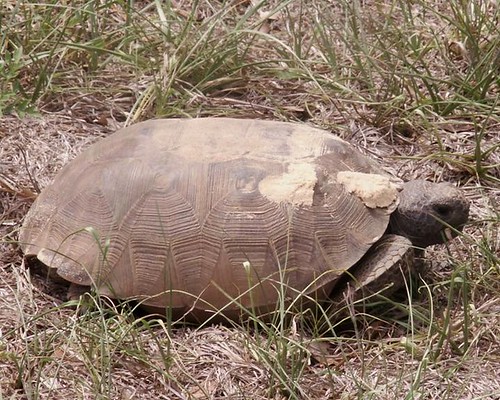
Florida lists the gopher tortoise as a Species of Special Concern and considers it to be a keystone species. Write Catherine Puckett and Richard Franz in their article, "Gopher Tortoise: A Species in Decline," "Gopher tortoises (Gopherus polyphemus) burrow into the earth, building homes for themselves and havens for many other animals. Along with scrub jays, burrowing owls, and short-tailed snakes, ancestors of gopher tortoises were a part of the savanna fauna that migrated millions of years ago into the southeastern United States. Gopher tortoises belong to a group of land tortoises that originated in western North America nearly 60 million years ago. At least 23 species of these tortoises are known to have existed on our continent since that time, but only four remain today." The gopher tortoise is the only tortoise species found in the eastern United States.
The South Carolina Department of Natural Resources, citing NatureServe 2005, states that the gopher tortoise is "globally considered vulnerable."
Reporter Dan DeWitt of the St. Petersburg Times covered the story of gopher tortoises dying in the Withlacoochie State Forest, in "Tortoises in state forest dying off," November 21, 2005. One possible cause of the deaths had been well-meaning residents moving the tortoises away from land under development.
Wrote DeWitt, "Relocating tortoises, which is illegal, not only can introduce disease into a new population, it does nothing to protect tortoises because most natural areas in Florida already support as many tortoises as the habitat can bear."
The Citrus Tract, which includes forest land in our county, is considered to be a long-term refuge for the tortoises but is now at capacity for them.
In northern Florida, a female tortoise takes 10 to 15 years to reach adulthood; tortoises further north might take as long as 21 years to mature. While Puckett and Franz set the tortoise's life span "in excess of 40 years," the South Carolina DNR says, "possibly reaching 50 to 60 years, or greater." Gopher tortoises mate in April and May, so this one may have been looking for a companion.
Fortunately, this one was headed away from the road, toward the woods:
Another road is also being widened. And, near the library, forest land has been razed in preparation for a new subdivision.
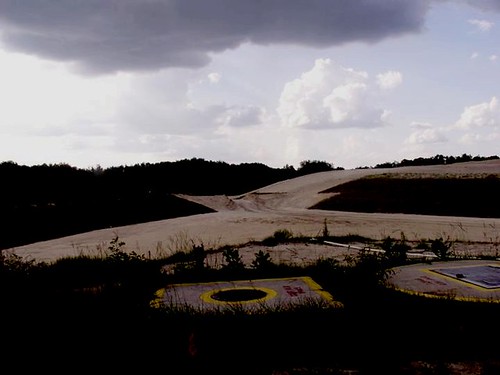
What remains of the woods is visible on the horizon.
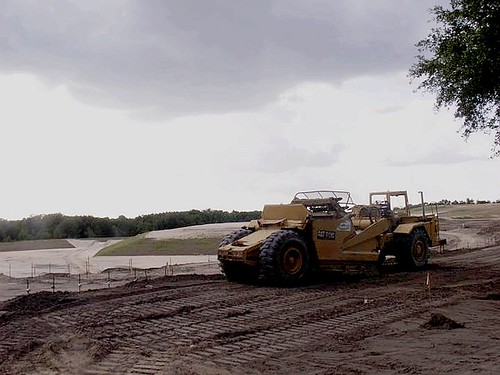
Sometimes I wonder if my camera helps me bear witness to a way of life and an ecosystem that will fade beneath the relentless pace of development. Mary and I come to this from different histories. She had grown up in a hiking family, in a southern California suburb whose population has mushroomed. Conversely, my upbringing in Brooklyn -- the 4th largest city in the US, according to one sign -- gave me an appreciation for small pockets of urban wildlife.
I am enjoying the Nature Coast, for however long it can live up to that name.
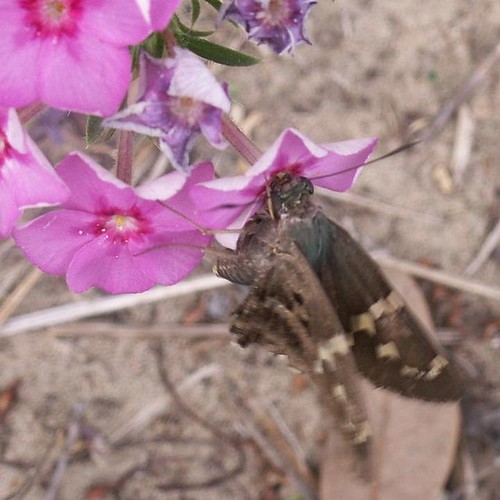
This Long-tailed Skipper was flitting around flowers growing next to the construction site.
Skippers have the characteristics of both butterflies and moths. According to our Audubon Society Field Guide to North American Insects and Spiders, they are called skippers due to their "rapid, direct, and bouncing flight."
The Long-tailed Skipper (Urbanus proteus, Family Hesperiidae) ranges from Connecticut to Florida, west to California, south to Mexico. It is rare in the Northwest and extreme West. Caterpillars feed on wild beans, mesquite, wisteria, cultivated beans, and a variety of other leguminous plants.
A Brown-Spotted Yellow Wing dragonfly was not so fortunate.
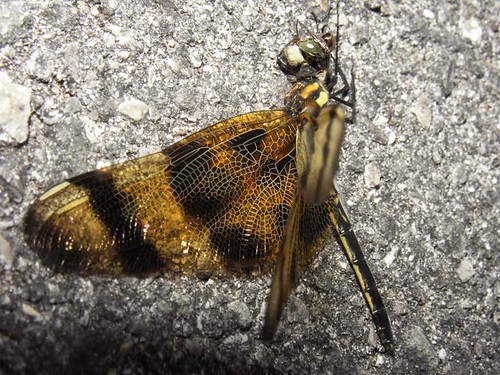
Mary and I had walked around six miles when we saw this poor thing dead in a church parking lot at close to 8 PM. I had a chance to squeeze off a shot before a brief spate of drizzle.
Also called Halloween Pennant, Celithemis eponina, Family Libellulidae (Common Skimmers). Its range is eastern North America. Its season in Florida is year-round (summer in northern parts of the state).
Says Bugguide.Net, "Males are not territorial, perch near edge of ponds, waiting for incoming females. Mating typically takes place in the morning. Oviposition is in tandem. Frequently seen perched on weeds in fields as it forages, pivoting with the wind."
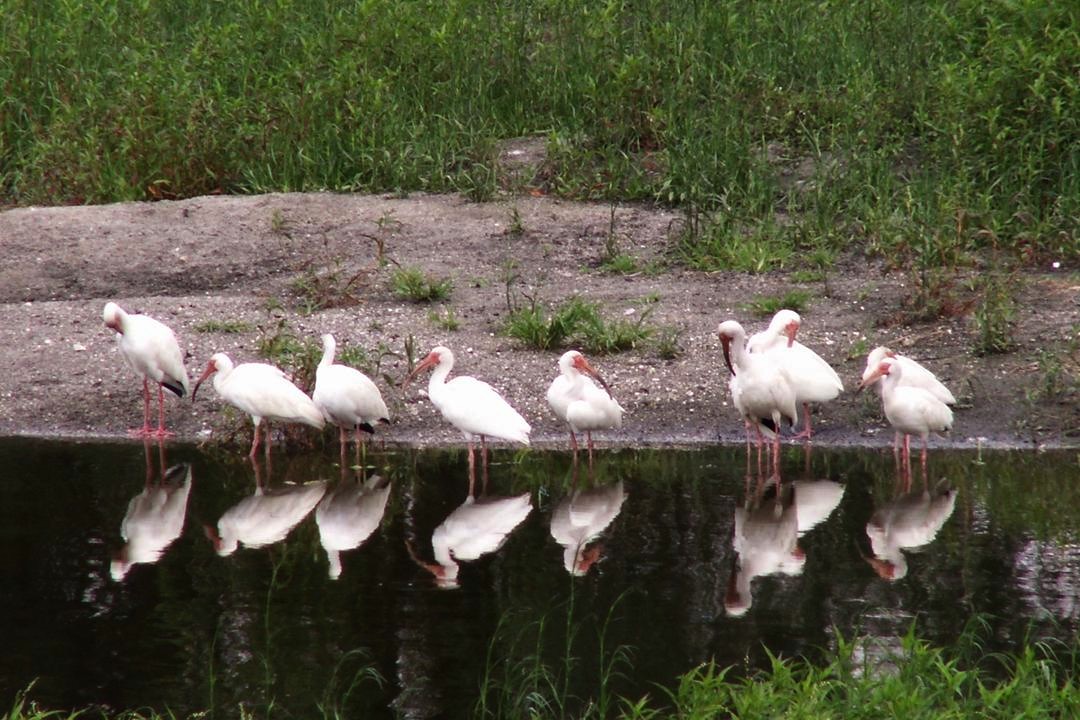
White Ibises, Eudocimus albus, Family Threskiornithidae. Ten of these birds had congregated at our "post office pond," unperturbed by the nearby sirens making an auditory appearance in the video below.
Says the Cornell Lab of Ornithology, "A wading bird of the deep South, the striking White Ibis is frequently seen on lawns looking for large insects as well as probing for prey along the shoreline."
Adds eNature.com, "Around their colonies, ibises eat crabs and crayfish, which in turn devour quantities of fish eggs. By keeping down the numbers of crayfish, the birds help increase fish populations. In addition, their droppings fertilize the water, greatly increasing the growth of plankton, the basic food of all marsh life. White Ibises gather at dusk in spectacular roosts, long lines of birds streaming in from all directions."
(Compare with the juvenile ibis at the St. Augustine Alligator Farm rookery.)
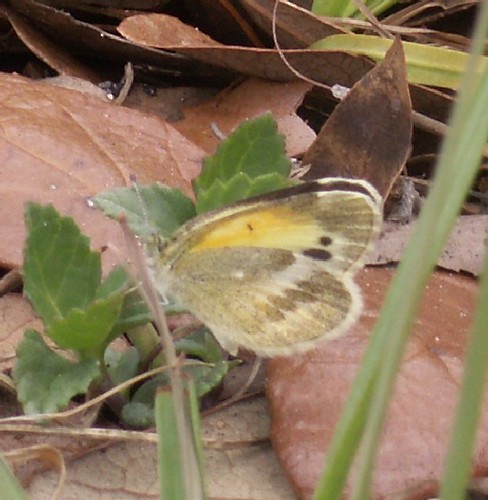
Back at the post office I found this Dainty Sulphur (Nathalis iole, Family Pieridae). Says Bugguide.Net: "Resident in Guatemala north to peninsular Florida and the Southwest. Cannot survive cold winters, therefore every summer re-colonizes through the Great Plains to southeast Washington, southeast Idaho, Wyoming, and Minnesota." This is the smallest sulphur butterfly in North America. Feeds on dogweed, marigold, and other asters. "Males patrol a few inches above the ground in low areas for females," Bugguide continues. "Females lay eggs singly on leaves of host plant seedlings. Adults rest with wings closed and held perpendicular to the sun's rays to warm themselves."
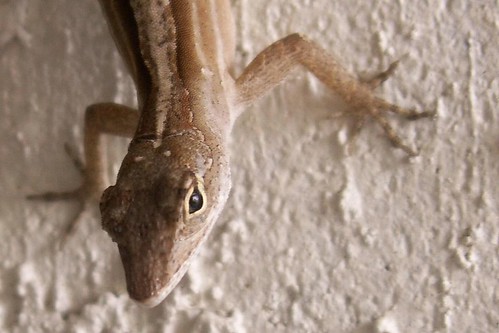
I found this beauty a couple doors down from the place where I get my photos printed. This is the closest I've been able to get to one of these lizards with the camera, and she held her position beautifully. Though I suspect she was thinking that if she didn't move, maybe the big creature won't try to eat her.
I hope instead that she had picked up on my vibes telling her how pretty she is.
I still have trouble telling brown and green anoles apart (for one thing, green anoles can turn brown, though the reverse is not the case). But the slender build makes me think this might be a green anole (Anolis carolinensis, Family Polychrotidae), the only anole native to the United States. Unfortunately, green anoles are losing habitat to the brown anole (Anolis sagrei).
Tom Spinker's Florida and Georgia Anoles page has great comparison photos. The white stripe down this one's back makes me think it's a green anole and possibly a female. Says Spinker, "A Green Anole with a white stripe down the middle of its back is either a female or a juvenile male." In brown anoles, a yellow stripe down the back indicates a female.
A shot of white bushy asters and another of an old magnolia blossom yielded this collage:
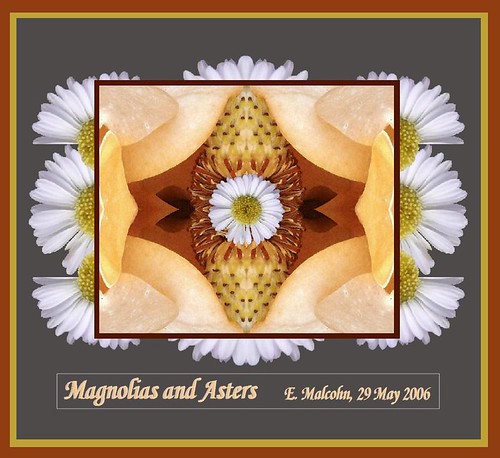











0 Comments:
Post a Comment
<< Home